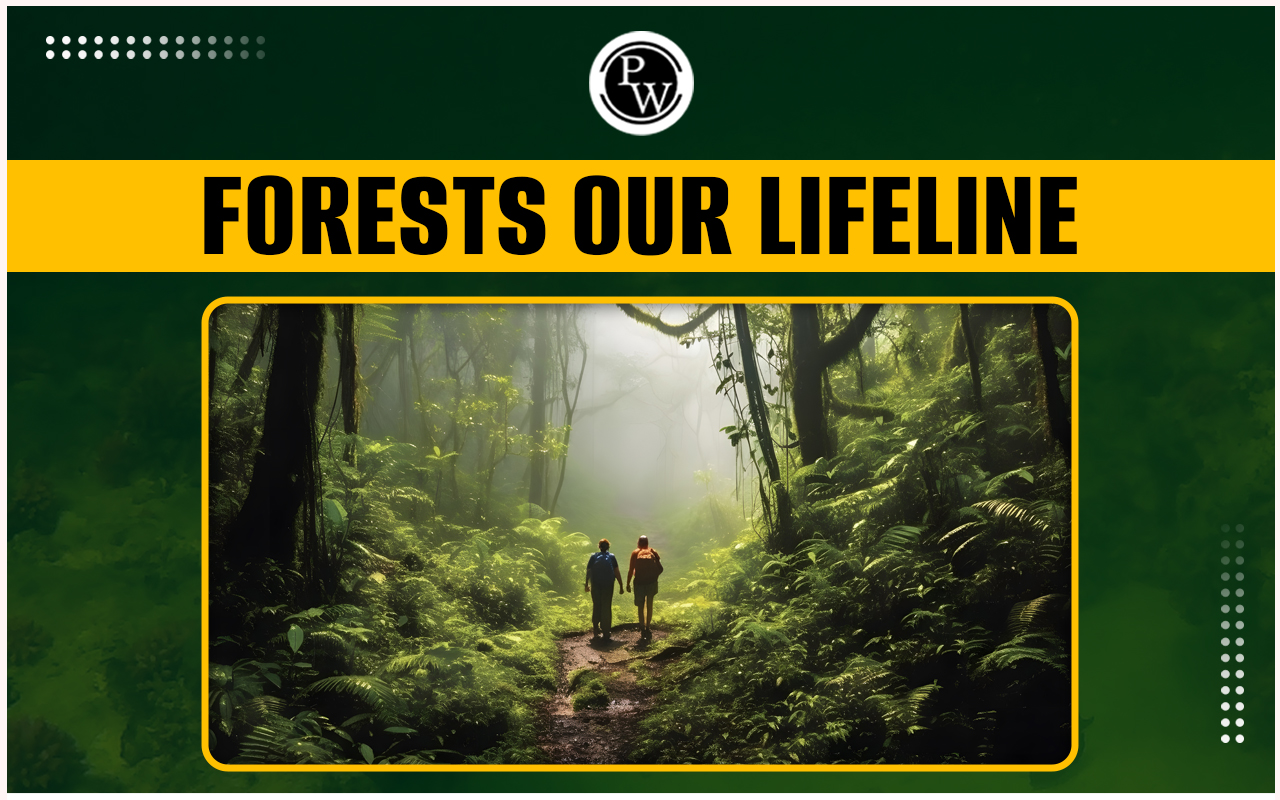

Forest Structure: If you want to know about forests and why they are essential for us, then you are at the right place! Have you ever wondered what makes them so important for living beings?
Let us discuss some of the necessary details about forests in this article. We will also discuss a forest's features, what it comprises, and the layers in which it is divided. At the end of this article, you will clearly understand the status of forests and their categorisation. And also, their importance will give a clear idea that forests should be conserved and humans should properly use their resources for their needs.Introduction
The land on earth has immense biodiversity with various living species around us. Human beings and other living species have formed a complex ecological system. Forests are vast lands consisting majorly of trees and thick vegetation. It also has several microorganisms, plants, animals, fungi, decomposers, etc. Forests consist of many trees and producers, which help produce oxygen for living organisms, aid in cooling the air during the day, and are great sound absorbents. Forest also provides resources like rubber, timber, wood, medicine, dyes, fuel, etc. They are called green lungs and also help in water purification. Forests grow and regenerate independently and constitute one-third of the earth's land. Deforestation is a major problem in which forest lands are cleared for other human use. The overuse of forest resources can also cause damage to ecological systems. This, in turn, can be disadvantageous for us as well. Thus, it is essential to use resources judiciously and plant more trees.Forest Structure
Since forests is largely dominated by trees. We see huge trees all over the forest land. The structure of the forest is thus categorised based on the layers.- The first emergent layer has huge trees with a crown at the peak. The crown is the branchy portion of the tree over the stem. The trees have tiny leaves in the emergent layer, which help them to endure heavy winds. Different varieties of trees show variation in their crowns. Also, based on the tree heights, the crown height differs in the forest.
- Canopy - The branches of tall trees cover that area like a roof spread over the other smaller plants of the forest. This is called a canopy which forms the roofing or shading over other plants and the ground. The trees have broad leaves, bringing the roof effect and allowing the rainwater to flow slowly toward the ground. The canopy receives maximum sunlight and only allows a small amount of light to cross and reach the other layers of the forest land.
- Understory - The crown of smaller trees forms a layer at lower heights. This is called the understory. It includes lower trees and shrubs whose branching is lower. Limited sunlight penetrates the area towards the ground. Therefore, it is mostly dark and humid.
- Ground or Floor - The last layer consists of the microbes and plant debris; the microorganism decomposes the debris and fertilises the soil. The ground is mostly soft and moist, and it is favourable for the growth of plants.
Importance and Advantages
The large area covering high-concentration trees is called a forest. They are of high importance to all of us in many ways. Some advantages of forests are as follows:- They are a habitat for various plant and animal species.
- They help promote rainfall and maintain the earth's water cycle.
- They clear and purify the air by removing carbon dioxide and producing oxygen from green plants. This also helps keep a check on global warming by removing carbon dioxide.
- These maintain the climatic conditions, bring moisture, and lower the earth's temperature.
- Forests absorb sound and thus help reduce the noise pollution created by human activities.
- They provide ecological balance to the environment.
- They also provide a livelihood to humans through their resources like wood timber, gum, rubber, resins, oils and waxes, spices, medicinal products, and many more.
- Forest trees hold the soil and prevent it from being eroded, keeping the land fertile and soft. It brings protection from flash floods by lowering the water flow.
- They can naturally absorb a massive amount of water and sustain its flow. During heavy rainfall, the rainwater flows through the leaves of the trees without falling directly on the ground. It is slowly absorbed by the roots preventing it from flooding.
- Plants in nature produce enormous seeds. The forest floor is fertile and generally damp, to make it favourable for seed germination and the growth of plants.
Deforestation and its Effects
Cutting down forests on a large scale to make them available for other uses like agriculture, industrialisation , homes, raw materials, etc. are called deforestation. Increasing human demands have consequently led to rising levels of deforestation. It has adversely impacted the ecosystem as the species living in the forest are highly affected. There is a great loss of biodiversity due to deforestation. Fewer plants have caused climatic changes, more pollution , and increased atmospheric carbon dioxide levels, increasing global temperature. Glaciers are melting due to the increasing earth’s temperature, affecting the lives of many organisms living in colder areas. Consequently, the water level has risen to a greater concern. Deforestation has also resulted in more soil erosion . Since the soil is left loosened and no trees hold the soil with their roots. The soil gets eroded, making the land barren, dry, and unfavourable for plant growth. Planting more trees, using recycled products and paper, avoiding the use of firewood, spreading awareness to the public, and making informed choices are some of the key ways to prevent deforestation.Related Links -
Forest Structure <span style=
Q1- What is a forest?
Ans- A forest is a large area mostly having trees as the dominant life form. It includes trees, plants, herbs, shrubs, fungi, microorganisms, animals, etc.
Q2- Give any three importance of forest.
Ans- The three importance of forest are as follows:
Forests are a habitat for a wide range of flora and fauna. It has a rich biodiversity.
Forests are called green lungs as they purify the air by absorbing carbon dioxide and releasing oxygen into the atmosphere.
Forests are great sound absorbers as trees absorb the sound of higher frequencies and reduce noise pollution.
Q3- What are the layers of forest structure?
Ans- The forest is divided into different layers or strata. This is also called stratification. The different layers are the emergent layer, canopy, understory, and the ground.
Q4- How does a forest prevents floods?
Ans- Large trees and their roots absorb higher quantities of water. Heavy rainfall does not lead to the water falling directly on the ground; rather, the rainwater falls slowly and swiftly through the trees from their leaves. This helps the water seep through the ground, and forests absorb a lot of water, which helps prevent flooding.
🔥 Trending Blogs
Talk to a counsellorHave doubts? Our support team will be happy to assist you!

Free Learning Resources
PW Books
Notes (Class 10-12)
PW Study Materials
Notes (Class 6-9)
Ncert Solutions
Govt Exams
Class 6th to 12th Online Courses
Govt Job Exams Courses
UPSC Coaching
Defence Exam Coaching
Gate Exam Coaching
Other Exams
Know about Physics Wallah
Physics Wallah is an Indian edtech platform that provides accessible & comprehensive learning experiences to students from Class 6th to postgraduate level. We also provide extensive NCERT solutions, sample paper, NEET, JEE Mains, BITSAT previous year papers & more such resources to students. Physics Wallah also caters to over 3.5 million registered students and over 78 lakh+ Youtube subscribers with 4.8 rating on its app.
We Stand Out because
We provide students with intensive courses with India’s qualified & experienced faculties & mentors. PW strives to make the learning experience comprehensive and accessible for students of all sections of society. We believe in empowering every single student who couldn't dream of a good career in engineering and medical field earlier.
Our Key Focus Areas
Physics Wallah's main focus is to make the learning experience as economical as possible for all students. With our affordable courses like Lakshya, Udaan and Arjuna and many others, we have been able to provide a platform for lakhs of aspirants. From providing Chemistry, Maths, Physics formula to giving e-books of eminent authors like RD Sharma, RS Aggarwal and Lakhmir Singh, PW focuses on every single student's need for preparation.
What Makes Us Different
Physics Wallah strives to develop a comprehensive pedagogical structure for students, where they get a state-of-the-art learning experience with study material and resources. Apart from catering students preparing for JEE Mains and NEET, PW also provides study material for each state board like Uttar Pradesh, Bihar, and others
Copyright © 2025 Physicswallah Limited All rights reserved.
Get App











